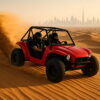Picture yourself racing across golden sands, wind in your face, and a powerful engine roaring beneath you. A dune buggy adventure delivers thrilling action and stunning scenery. Proper preparation, however, is key to making the most of your first ride.
This beginner’s guide will help you get ready from choosing the right vehicle and gear to learning techniques and finding the best destinations.
Choosing the Right Dune Buggy
Selecting the perfect dune buggy is one of the most crucial steps to a great adventure. Whether you’re renting one for the day or considering a purchase, here’s what you need to keep in mind.
Factors to Consider
- Engine Size
Think about what kind of adventure you’re signing up for. A small engine (under 600cc) is ideal for light recreational riding and beginners, while larger engines (800cc–1000cc) are better for more powerful rides over challenging terrain.
- Suspension
The terrain you choose dictates the suspension type you need. A high-quality suspension system can handle bumps and dips, making it essential for uneven or steep dunes.
- Safety Features
Look for vehicles equipped with roll cages, harness seat belts, and fire extinguishers. Safety should never be compromised, especially for first-time riders.
Renting vs. Buying
- Renting
Renting a dune buggy is the most practical option for beginners. Dune buggy rentals typically cost between $100 to $300 per day, depending on the model and location. This approach allows you to try out different types before committing to a purchase.
- Buying
Buying is ideal for enthusiasts planning to ride frequently. A brand-new dune buggy can cost anywhere from $5,000 to $20,000, depending on the features and build quality. If you’re really committed to dune buggy riding as a hobby, investing in your own vehicle can save money in the long run.
Essential Gear and Preparation
Equipping yourself with the right gear can make all the difference between a safe, thrilling ride and a risky, uncomfortable experience. Proper preparation not only enhances your overall enjoyment but also ensures you’re protected from potential hazards.
Safety First
When it comes to hitting the dunes, safety should always come first. The right gear is an investment in your well-being, so don’t cut corners. Here are the essentials you need:
- Helmet: A high-quality, DOT-approved helmet is non-negotiable. It offers critical head protection in case of falls or accidents, reducing the risk of serious injury. Make sure it fits snugly and comfortably for maximum effectiveness.
- Goggles: Sand and debris can be a major issue when riding, and durable, anti-fog goggles are crucial to keep your vision clear. Look for goggles with UV protection and a secure fit to ensure they stay in place while you’re on the move.
- Protective Clothing: Long sleeves, gloves, and sturdy boots are your best defense against scrapes, cuts, and exposure to the elements. Choose breathable yet durable materials to keep you comfortable while offering full protection during your ride.
By prioritizing this essential gear, you’ll be better prepared to enjoy the thrill of the dunes with confidence and peace of mind.
Navigation and Communication
Exploring on your own? Don’t get lost in the vast dunes!
- GPS and Maps: Reliable navigation tools are a must if you’re heading into unfamiliar terrain. Some rental companies provide GPS systems with their vehicles.
- Radios: Ensure you have a two-way radio to stay connected with your group or call for help in emergencies.
Tool Kit
Nature can be unpredictable, and a well-stocked tool kit could save your adventure. Carry basic tools like wrenches, screwdrivers, tire irons, and a portable air compressor for quick repairs.
Understanding Dune Buggy Driving Techniques
Driving a dune buggy isn’t like navigating regular roads. The sand presents unique challenges, but with a bit of practice, you can master it.
Mastering Sand Dunes
When approaching sand dunes, avoid driving straight up steep hills. Instead, approach at an angle to prevent the buggy from stalling or tipping over. Always leave enough distance between vehicles to avoid collisions.
Handling Different Terrain
- Soft Sand: Lower your tire pressure for better traction. Keep your speed consistent to avoid sinking.
- Hard Pack: Hard-packed sand provides better traction and an easier drive but can feel more bumpy.
- Transitions: Stay cautious when moving between different terrain types, as sudden changes in traction can cause loss of control.
Safety Tips
- Always be mindful of your surroundings. Look out for other riders, wildlife, and sudden drops.
- Avoid sharp turns at high speeds to reduce the risk of flipping.
- Never ride alone; always go with a group or have someone nearby for assistance.
Popular Dune Buggy Locations
Once you’ve mastered the basics, it’s time to explore some of the most iconic dune buggy spots.
Glamis Sand Dunes, California
Known as the crown jewel of duning, the Glamis Sand Dunes attract enthusiasts from all over the world. With over 40 miles of sandy terrain, it’s a paradise for adventure lovers.
Imperial Sand Dunes Recreation Area, California
If you’re looking for expansive views and challenging rides, the Imperial Sand Dunes won’t disappoint. It’s ideal for both beginners and seasoned riders, offering a range of difficulty levels.
Little Sahara Recreation Area, Utah
This stunning location is perfect for a self drive dune buggy ride. It boasts 60,000 acres of sand dunes with areas specifically designated for beginners and families.
Making the Most of Your First Adventure
Your first dune buggy ride should be unforgettable. With the right preparation, gear, and techniques, you’ll be ready for success.
Ready to hit the dunes? Book your dune buggy today! Whether you want to drive yourself or join a guided ride, there’s something for everyone.
Share your dune buggy adventures with us!






